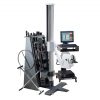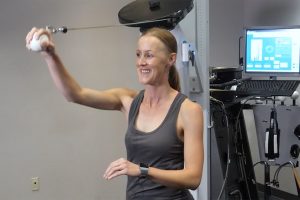
Shoulder Impingement vs. Rotator Cuff Tear: Diagnostic and Treatment Insights for Clinicians
Treatment GuidelinesUnderstand shoulder impingement vs rotator cuff tear through a clinician’s lens with diagnostic strategies, imaging choices, and therapeutic approaches.
Many other injuries can present remarkably similar to rotator cuff tears. So if a patient presents with shoulder pain, what should you consider? Here’s everything you need to know about a shoulder impingement vs rotator cuff tear.
If it looks like a duck, walks like a duck, and quacks like a duck, then it’s a duck. Right? Not always. In an orthopedic setting, many different common injuries can present in the same way. That’s why differential diagnosis is such an important tool. Specifically, rotator cuff injuries have many “copycats.”
Typically, rotator cuff tears cause shoulder pain, weakness, and limited range of motion. However, many other shoulder injuries can present in a remarkably similar way. So if a patient presents with shoulder pain, what should you consider besides a rotator cuff tear? Here’s everything you need to know for a rotator cuff differential diagnosis.
Understanding Shoulder Anatomy and Pathophysiology
There are many muscles and tendons around the shoulder joint. The rotator cuff has four muscles:
- Supraspinatus – This muscle stretches from the shoulder blade to the end of the upper arm bone. It helps lift and rotate the arm.
- Infraspinatus – It’s attached to the bottom of the shoulder blade and behind the upper arm bone and supraspinatus. It works with the supraspinatus to help rotate the arm.
- Teres minor – This muscle stretches from the outside of the shoulder blade and attaches to the upper arm bone beneath the infraspinatus. It’s another muscle that helps turn and rotate the arm.
- Subscapularis – It’s attached to the middle of the shoulder blade and stretches to the humeral head (ball-shaped end of the upper arm bone). It helps stretch the arm away from the body.
Shoulder Impingement vs Rotator Cuff Tear
Shoulder impingement syndrome has very similar symptoms to a rotator cuff tear, which is why people often mistake the two. While a rotator cuff tear refers to an injury to one or more of the rotator cuff muscles, shoulder impingement is when part of the rotator cuff gets pinched beneath the shoulder blade. Both can cause intense shoulder pain when moving the arm.
More specifically, impingement involves rotator cuff tendons getting compressed under the acromion (a bony projection on top of the shoulder blade). Every time the arm moves with this condition, the tendons get pinched, which can lead to tendonitis. The pain of a rotator cuff tear can feel similar, but it instead involves partial or full-thickness complete tears of the tendons, typically caused by deterioration or a traumatic injury.
Other Rotator Cuff Injuries
First, we’ll consider other rotator cuff injuries. It may still be the rotator cuff, but instead of a tear, the tendons may be irritated or damaged. Many of the same symptoms still apply – pain at activity and rest, radiating from the shoulder down the side of the arm. The pain may increase with specific movements and eventually progress to loss of strength or range of motion.
What might these injuries include?
- Rotator cuff tendinitis
- Rotator cuff bursitis
- Biceps tendinitis
- Other kinds of tears
Types of Shoulder Tears
Alternatively, something may be torn, but it may not be the rotator cuff. The complex shoulder joint hosts several tendons, muscles, and surrounding tissues. These tears can lead to pain, decreased mobility, weakness, and sometimes a catching feeling when moving the shoulder.
A rotator cuff differential diagnosis should consider these common shoulder tears types:
SLAP Tear
Superior Labrum from Anterior to Posterior tear is named for the type and direction of the tear involved. A labrum tear vs rotator cuff tear differs because labrum tears specifically affect the cartilage stabilizing the shoulder joint, rather than the muscles and tendons surrounding it.
Bankart Tear
This tear is caused by dislocation, instead of the other way around. The labrum tears, but in a different direction than a SLAP tear. After tearing, it is weaker and cannot stabilize the shoulder. This weakness may lead to repeated shoulder dislocations.
Biceps Tendon Tear
Although often associated with the rotator cuff, the biceps tendon is not officially part of the grouping. However, the long head of the biceps tendon helps attach the humerus to the scapula and works closely with the rotator cuff tendons. As a result, a biceps tendon tear will closely mimic the rotator cuff tear symptoms.
Completely Different Shoulder Injuries
Yet another possibility to consider is an entirely different type of shoulder problem. Rather than the soft tissue, there could be a dysfunction of the joint itself. These injuries will still cause pain, loss of range of motion, and grinding sensations or crepitus.
Though there are plenty of other shoulder injuries to consider as part of a rotator cuff differential diagnosis. Some of the most common are:
- Shoulder fracture: Typically more acute, accompanied by severe pain, and often swelling, bruising, and deformity.
- Dislocation: Anterior or posterior, often occurring after a specific trauma.
- Adhesive Capsulitis (frozen shoulder): Generally presents as pain that gradually increases and leads to a drastic or complete loss of range of motion.
- Osteoarthritis: Typically located more posteriorly and deep within the joint, compared to rotator cuff injuries.
Nerve Conditions
In addition to the tissue and joint issues above, some nerve conditions can present similarly to rotator cuff injuries. Typical rotator cuff tear symptoms can be replicated by pinched or damaged nerves. If your patient is presenting with shoulder pain, limited range of motion, and weakness, you may also want to look into the following:
- Fibromyalgia
- Rheumatoid Arthritis
- Complex Regional Pain Syndrome
- Thoracic Outlet Syndrome
- Neuropathy
- Brachial Plexus Injury
- Cervical Radiculopathy
Diagnostic Tools for Rotator Cuff Differential Diagnosis
The most definitive way to establish an accurate shoulder pain diagnosis is via arthroscopy or operative findings. However, other testing methods are less invasive and can help us determine a shoulder impingement vs rotator cuff tear or another shoulder injury.
-
Physical Testing and Exam
A thorough shoulder evaluation begins with a patient history and physical exam. A complete history can often be the determining factor in a correct diagnosis. Standardized tests, such as the DASH or the COPM can help us to find quantifiable answers to our questions about pain and daily function.
Range of motion and strength testing provide important baseline measurements. Here are a few great physical tests for shoulder tears:
- Neer’s Impingement Test – The examiner stabilizes the patient’s shoulder blade and passively flexes their arm while it’s internally rotated. The goal is to determine if the patient feels any pain, which indicates shoulder impingement syndrome.
- Hawkins-Kennedy Test – The examiner flexes the patient’s arm and shoulder 90 degrees and internally rotates the arm. Like Neer’s Test, this is to see if they feel pain related to shoulder impingement.
- Empty Can Test – The patient’s arm is lifted 90 degrees and moved slightly back. The shoulder will be rotated as if they’re pouring the contents out of a can. Then, the patient lifts their arm up while the examiner applies resistance. If pain and arm weakness are present, there’s likely a rotator cuff tear.
- Drop Arm Test – The examiner passively lifts the patient’s arm to 90 degrees. They will release the arm, and the patient tries to gradually lower their arm back to their side. If there is a massive rotator cuff tear, they will have little to no control over their arm when it’s dropped.

If you use objective evaluation tools, you can later compare results to show progress over time. Palpation of bony prominences, tendon heads, and other surrounding “landmarks” can give a clear picture of the level of involvement. Learn more about specific clinical tests in this article: Rotator Cuff Evaluation: Standardized Tests, Strength, ROM, and Questionnaires.
-
Imaging
MRI
MRIs can identify a shoulder tear, measure its severity, and provide information on the surrounding tissue. MRIs are also helpful in determining anomalies in the labrum, ligaments, and other tendons. The imaging can assess muscle atrophy (thinning of muscle mass) and fatty infiltration (accumulation of fat within tissue), to help with surgery planning.
Ultrasound
An ultrasound is more helpful in examining soft tissues. Ultrasound can help to assess subacromial impingement syndrome, shoulder bursitis, and degenerative arthritic changes in real-time through dynamic assessments, such as observing tendon movements while elevating the arm.
X-rays
X-rays can help rule out other diagnoses. For example, a chest X-ray may reveal bone spurs surrounding the rotator cuff tendons. These may be causing rotator cuff tendinitis or impingement. An X-ray is also the most common way to rule out a shoulder fracture and can indicate degenerative changes caused by arthritis.
-
Nerve Studies
A nerve study is another method to evaluate the function of the shoulder joint. Nerve conduction studies (NCS) and needle electromyography (NEMG) can determine the functional abilities of the nerves that innervate the shoulder muscles. They can provide diagnostic information on nerve injury, impingement, entrapment, radiculopathy, and thoracic outlet syndrome (TOS).
Treatment Protocols
The treatment plan your patient needs depends on the test results. Discuss the importance of modifying activities to the patient’s needs and committing to the rehabilitation programs with your patient to set them up for success.
Physical Therapy
In many cases, you can fix shoulder pain without surgery. Physical therapy can include exercises designed to strengthen the rotator cuff and scapular stabilizers, along with the use of NSAIDs and corticosteroid injections as needed. Providers should assess the severity and location of the shoulder pain to create a tailored physical therapy schedule.
Surgery
Extreme rotator cuff tears and other shoulder injuries may require surgical treatment. A shoulder impingement vs rotator cuff tear will have different surgery options.
If physical therapy and pain medications don’t relieve pain, that’s when the patient may need rotator cuff repair. After surgery, the patient will need to focus on passive exercises to allow time to heal. Then, they can gradually start practicing a range of motion exercises with that arm.
For shoulder impingement, subacromial decompression is a procedure to release the pinched tendons and create more space to prevent future impingements. Patients can begin physical therapy shortly after surgery, and it can take a few months to return to normal activities.
Comprehensive Assessments: Key to Effective Treatment Plans
Although rotator cuff tears are the leading cause of shoulder pain in the United States, they are not always to blame! A rotator cuff differential diagnosis will help us identify shoulder impingement vs rotator cuff tear and many other possible causes of shoulder pain, weakness, and loss of mobility. By utilizing a comprehensive physical exam, a complete patient history, incorporating special tests, and ordering imaging and nerve studies as appropriate, we can ensure we get our patients the help they need.
Sydney Moninger, COTA/L is an Occupational Therapy Assistant and freelance writer. She has more than 10 years of clinical experience working in pediatric, orthopedic, and geriatric settings. Most recently, she has been helping patients at a pain management center for orthopedic injuries. Sydney is passionate about patient education and increasing health literacy in the community, which is what got her started in her writing in the first place. She loves discovering new perspectives that improve her clinical practice, and connecting with others on LinkedIn or her Upwork page.






